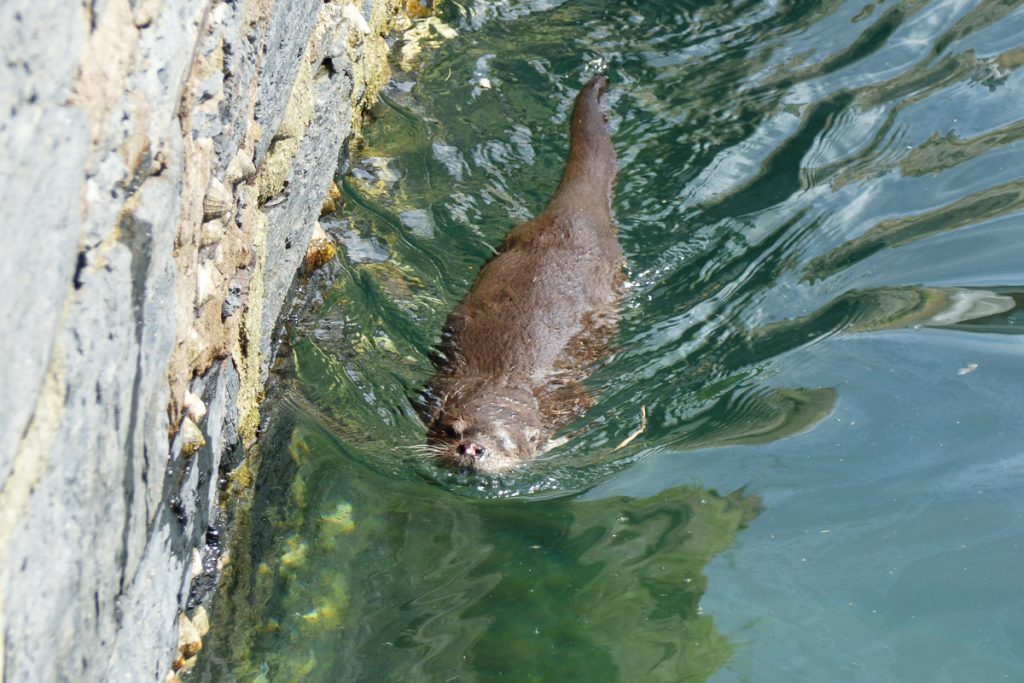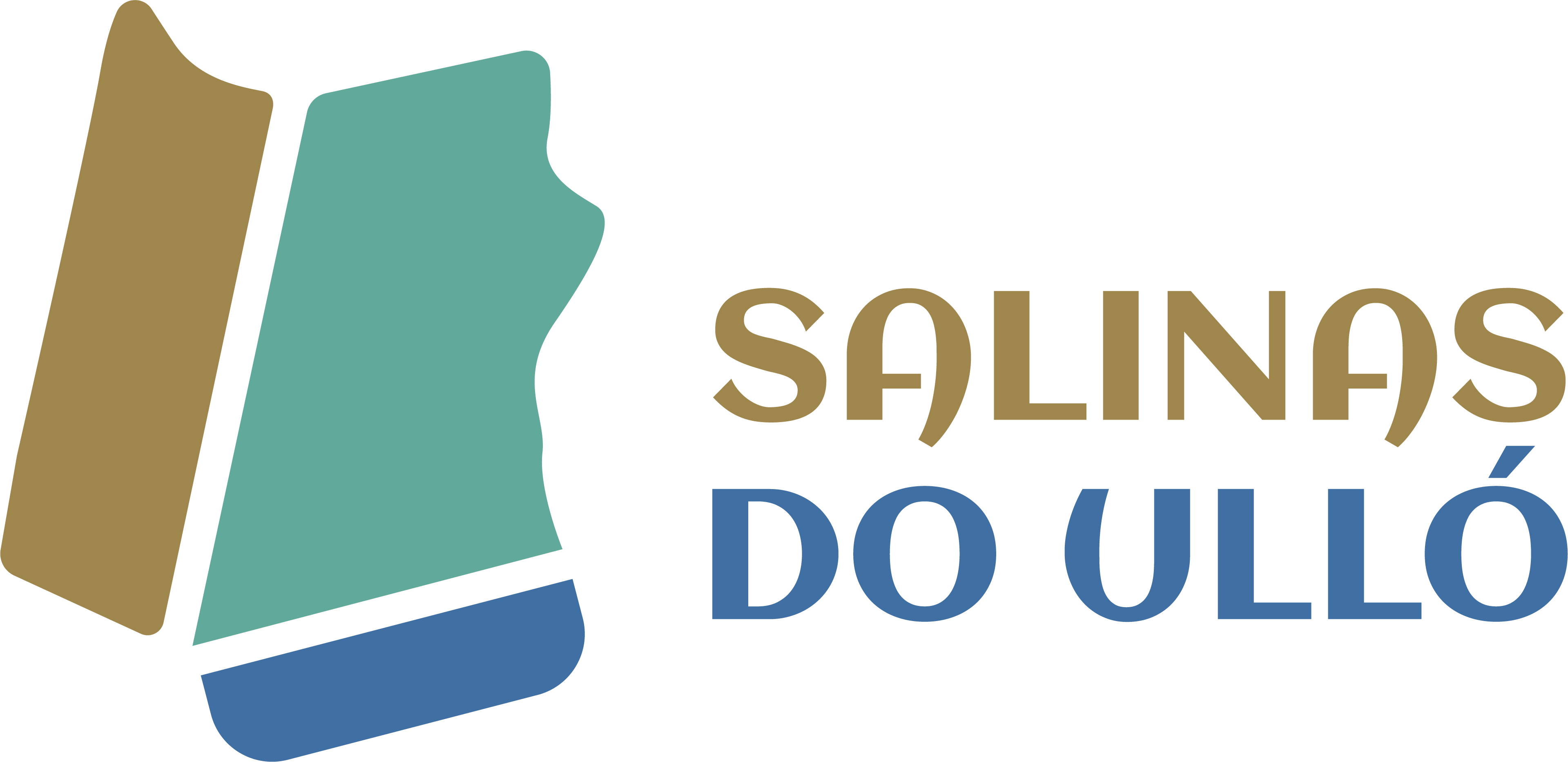A lifetime is not enough to know all the animal and plant species that live in such a rich habitat as the Salinas de O Ulló and Larache and their surroundings. But we can focus on some that amaze us, that stand out and that cannot go unnoticed by any visitor to the place or resident of Vilaboa.


Do you know the sea lettuce? How were the brooms of the times before ours? Did you know that before the potato there was the chestnut? That together with stinging nettles gives us the antidote, that there is an "azoutacristos" (butcher's broom) in the woods?
In this space lettuce grows in the sea (Ulva sp.). But it is not the lettuce of the orchards, but seaweed that resembles the land lettuce, which also has culinary properties. This seaweed, which grows on rocks or directly on the sand, even on other living creatures such as mussels (Mytilus galloprovincialis), can form real meadows or "vegetable gardens" in shallow areas with plenty of sunlight.

Before plastic and aluminium brooms were invented, we had a "broom" in our homes. A long branch of the broom or "xesta das vasoiras" (Cytisus sp and Erica sp.) tied at the end to join its stems in a circular shape. It was the tool used to clean the floors of houses and taverns on the coast and inland; it was also the main means of transport for witches...

The chestnut tree (Castenea sativa) has chestnuts as its fruit. In the November magosto (chestnut party) each chestnut is the soul of a deceased person who came to celebrate the day and night. With indications that chestnuts have been with us since the last perpetual snows, it was the Romans who introduced more productive varieties, together with wine, which adapted to our climate.


It was food until the 19th century, when the potato (Solanum tuberosum) and maize (Zea mays) took the first place. They were eaten roasted, but also cooked, in broth and even with milk. Hedgehogs are good fuel and chestnuts also feed domestic livestock and wildlife.
They say that if you hold your breath, nettles (Urtica dioica) don't sting. But sadly we all have memories of the sting of this plant that grows in meadows and along roadsides. What many people don't know is that its antidote seems like it is growing right next to them. It is mint and mentrastes (Mentha suaveolens). Rubbing a leaf on the bite soothes it and makes it more bearable. It is also very useful against ticks (superfamily Ixodoidea) as it scares them away. Often the solution is the problem's neighbour. The luck of biodiversity.


At the foot of chestnut trees (Castenea sativa), alders (Alnus glutinosa) and ash trees (Fraxilus sp.) grows a very curious shrub. Mistaken for holly (Ilex aquifolium) because of its red fruit, butcher's broom (Ruscus aculeatus) does not reach the size of its more arboreal cousin, but retains a comparable beauty. Even if you see other animals eating its fruits, they are toxic for us and should not be eaten. But the plant is an effective anti-inflammatory, and because it has consistency and stiffness, it has competed with broom (Cytisus sp and Erica sp.) in its soil-cleansing function. Its green leaves are not true leaves, but a transformation of the stem, where the true, small, clear leaves grow, on which the flower and round fruit then appear. It has as many names as uses, but the rich vocabulary includes such beautiful names as starfish (in Galician, rañacú), or butcher's broom (in Galician sil(v)barda, (x)silvareira or azoutacristos). Remember that only the female stems bear fruit, just like its cousin the holly (Ilex aquifolium).




The rocks are covered with mussels (Mytilus galloprovincialis), limpets (Patella sp.) and sea acorns (Chthamalus sp.). All three are marine invertebrates that can be found in the Salinas de O Ulló and Larache. These curious animals are capable of surviving out of the water for a considerable time and remain clinging to the rocks, withstanding the blows of the sea in the most exposed areas. Mussels (Mytilus galloprovincialis) are filter feeders of the water they feed on and also indicators of the health of the sea. By not moving from their anchorage, they are witnesses to what is happening, from the detection of red tides to research revealing the accumulation of microplastics in the oceans and seas.



Out of water, terrestrial invertebrates are the most abundant number of species. Among insects we already find the greatest diversity. We also have molluscs, such as the arion or slug (Arion sp.) and the snail (Cornu aspersum) and also annelids, such as earthworms (subclass Oligochaeta).


We cannot ignore the presence of an exotic and invasive insect that is causing problems for bees (Apis mellifera) and the European hornet (Vespa crabro). This is the Asian hornet (Vespa velutina), which feeds by preying during the day on wasps (Vespula vulgaris), bees (Apis mellifera), ants (family Formicidae), butterflies (order Lepidoptera) and also on fruit and meat. At night, this wasp hides in round nests that it builds in the treetops but also in the undergrowth, close to the ground. In the Ulló and Larache salt marshes we can find a natural predator of them, the European honey buzzard (Pernis apivorus), and a bird of prey that arrives in summer from the African continent to breed in our lands.

The native European hornet (Vespa crabro) is also suffering from its resemblance to the Asian hornet (Vespa velutina), being killed by our control techniques, even though it is harmless to us. We must learn to differentiate between the two species.




When walking near a honeysuckle (Lonicera sp.) and an orange-winged butterfly rises, we may be witnessing the agile and swift flight of the marsh fritillary (Euphydryas aurinia). Knowing that this flying insect feeds on them, it is necessary to keep it in the riparian forest and scrub areas.


The group of vertebrates, amphibians, reptiles, fish, birds and mammals is well represented in the salt marshes of O Ulló and Larache and in the cove of San Simón, as they do not understand territorial limits and have a great capacity for movement, whether by land, water or air.
In the marshes that remain without water, we may think that fish play little role, and it is true that they need water, but the mullet (Chelon labrosus, Mugil cephalus and other species) is one of those fantastic fish to which we pay little attention.
It goes without saying that we give the name muxo in Galician to several different species that live on our coastline, but differentiating them is a more complicated task.

Like the plants of the marshes, the mullet has the ability to withstand fresh water and can go up the rivers and streams at the bottom of the estuary, reaching the openings of the reservoirs. It eats whatever it can find, and if it has a reputation for being dirty, it is because we do not take enough care of what we throw into the sea.
It was not so long ago that toads and frogs were very useful to know in advance if a woman was pregnant. Beyond this curiosity, amphibians are an extremely valuable group of animals, capable of living and surviving both in and out of the water. Near the salt pans, where water channels are formed in the riparian forest, you can hear the repetitive sounds of frogs and toads, such as the Iberian frog (Rana iberica), the Moller´s tree frog (Hyla molleri) or the runner natterjack toad (Epidalea calamita), while others, such as the fire salamanders (Salamandra salamandra) and the Iberian newt (Lissotriton boscai, Lissotriton helveticus, Triturus marmoratus), are somewhat more humid and discreet.





The bottlenose dolphin (Tursiops truncatus) swims to the bottom of the estuary, next to the Alvedosas Islands, next to the Salt pans de O Ulló and Larache. This marine mammal shows its flank on the surface of the water alone or in pods. When they get too close to the beaches they can become stranded. In this case, what should we do? Report the incident quickly, prevent people from approaching, leave more than 10 metres away and do not make any noise. Call 112 and they will tell you what to do until technical assistance arrives.

From land, at specific times of the day and currents, two four-legged mammals approach the salt marshes. One of them is the otter (Lutra lutra), which walks through the intertidal space as if it were the queen of the place, looking for crabs, fish and invertebrates that get stranded in the water vessels when the tide goes out, but also birds that wander about.


So does the fox (Vulpes vulpes). Although more terrestrial, it may approach the marsh at dusk and at the beginning of the day. When it spots prey, it will stand still and stare at it, then leap forward to pounce on its food with its front claws.
If there is one group of animals that is truly attractive, it is the birds. Their ability to fly makes them unique. Many lovers of these animals pursue them, in a good way, on their tours of our estuaries at the times of the year when they arrive to breed from as far away as the African continent or when they stop to rest and continue their journey to lands further north or south. And those that accompany us all year round are also important. These include gulls (family Laridae), cormorants (Phalacrocorax sp.) and ducks (family Anatidae). An extensive group of species that feed and breed in the territory of the Salt marshes de O Ulló and Larache, in the estuary and on the cliffs and oceanic islands.




Birds of prey are top predators in a food chain and some of them have very strict and specialist diets. These species, more than others notice changes in habitats, as they are highly dependent on them.
The osprey (Pandion haliaetus) is one such specialist bird of prey. When it arrives from equatorial African countries it spends its time breeding on coastal rock cliffs and fishing. What do you mean, fishing? Well, yes. Hence its name. Its diet is 100% fish, which it catches by diving from the heights for the fish it spots during its flights in the inlets, estuaries and salt marshes such as those of Vilaboa.


